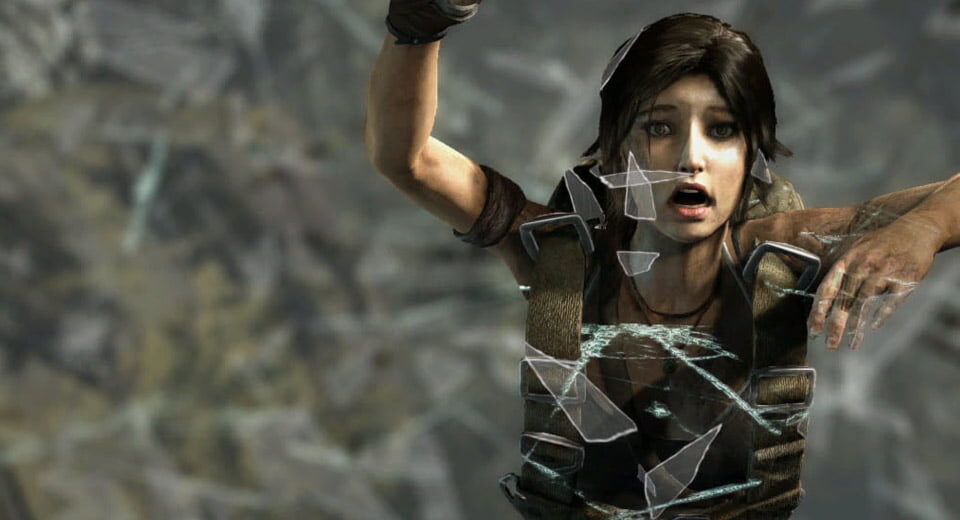2013 saw the reboot of the iconic Tomb Raider franchise, one which delved into the origins of Lara Croft.
Whilst the title received near universal praise, its achievements may have been overstated.
When discussing Tomb Raider it is difficult to openly criticise it, for there are elements which it is worthy of all praise put upon it. This primarily revolves around its depiction of women, likely helped by the inclusion of female lead writers. However the remaining elements of the title are not as strong and this includes the overall narrative and the wider gameplay implementation.
Many have praised the new depiction of Lara (including other writers at Thumbsticks), providing for a change a female power fantasy. One which ultimately sees Lara as the dominant force in her environment overcoming any and all challenges thrown at her (often literally). Whilst on the whole the portrayal of Lara and her struggles provides an adequate sense of progression on the part of the player and ultimately Lara, it is unfortunately inconsistent. This is largely in part to those around her providing a disconnect to what she has experienced, with the side characters being largely unsupportive of Lara, and their purpose mainly being to play to a stereotype and/or another victim to be killed off as if it was a horror film. Even those who do care are inconsistent, with one important side character not batting an eyelid at being rescued from heavily armed men followed by escaping an inferno, yet showing considerable concern when Lara goes to get supplies.
This inconsistency continues to one of the major identifying features of Lara Croft, that being her British background. In past titles the prominence of this have varied, and although this title does not pay too much attention to this fact they still made sure that the new voice actress was British. Unfortunately the person they chose (Camilla Luddington) has spent most of her time in California, and this is evident in the wonky British accent that is present. Without knowledge of the voice actress’ background it would not be difficult for some to assume an American was trying to put on a British accent. Although obviously it is nowhere near as bad as Dick Van Dyke or Shia LaBeouf’s recent efforts. Yet it was still enough to distract from what was taking place, especially when combined with inaccuracies regarding the choice of Americanisms that would not be used, such as elevator instead of lift. Then there is occasional confusion by the other characters who switch between referring to her as Lara one moment then Laura the next.
The story was completely forgettable, providing one which was not much better than the average Hollywood blockbuster. As previously mentioned it does do an adequate job at exploring Lara as a human being, showing her journey into maturity and her growth as someone strong and independent. Yet because of this all ancillary aspects were forgettable, and the strength of Lara’s journey was not enough to solely carry the game. Nor was the overall story, as often the game relied on set pieces, which primarily consisted of Lara tumbling down a different mountainside, to move her to a new location.
Throughout the game Lara’s character model reflects the journey she is going through, which is similar to Spec Ops: The Line, but unlike Spec Ops, outside of cutscenes this had little impact on how the game played. It is all dependent on upgrades, which adds to the disconnect between gameplay and narrative. Unlike The Last of Us, which is driven by the story of its main characters and supported by the environment they operate in. The Last of Us also does an excellent job of reinforcing the narrative through gameplay, in a way which generates a deeper connection with the characters that other mediums are unable to provide.
In terms of the gameplay provided in Tomb Raider, one cannot state that it is bad as it is perfectly functionable and on the whole plays well. However the overall experience seems incoherent. This is because the game often feels like it is trying too hard to be like other games such as Uncharted. Although unlike Uncharted there is a semi-open interconnectedness nature to the way the island is laid out, conjuring some comparison to Metroid Prime. Although there is minimal backtracking, and true exploration is entirely optional. This is a positive, as unless you are of a disposition to obtain more collectibles there is very little motivation to do so after reaching the credits.
Furthermore in trying to be like other titles it has lost much of the puzzle elements which contributed to its early appeal. The puzzles that do feature are often mediocre and are mostly relegated to optional tombs which are dotted around the island. Then there is the introduction of quick-time events (QTE). On the whole QTEs tend to be an annoyance and rarely add much to the experience aside from making sure the player is still involved in what would have previously been a passive cutscene. However their inclusion in Tomb Raider is dreadful with nearly every single QTE succeeding in dragging the player out of the experience. In addition to the hindrance that the QTEs bring to the player is that it is often difficult to determine when a cutscene has finished, which occasionally results in Lara’s death.
It is a shame that Tomb Raider suffers as a result of its many disparate parts. The premise of providing a new backstory for Lara is admirable, and is the most successful element to come out of the game. However this was by no means perfect and there was an unnecessary amount of tumbling down mountainsides that took place. Throughout Lara is subjected to a considerable amount of harm, although never quite enough to put her out of commission, but to the extent where it seemed gratuitous. One can accept the unrealistic amount of harm a character can receive in fictional scenarios like the one present. But it is the rationale behind the amount present in Tomb Raider which is of concern. The developers wanted to make sure that the player wants to look after Lara and prevent additional harm from coming to her. Yet the way in which they try to motivate the player is by putting her through as much physical trauma as possible whilst outside the player’s control, that they feel it is their responsibility to not put her in the way of any more harm.
The game also makes the player focus on the moment which sees Lara kill for the first time, and then shortly after the first time she kills someone with a gun. Both demonstrate different actions of survival, but it is the latter which is in self-defence that is meant to be more poignant. For it is during this event that it is implied that the man she kills had obscene desires involving her capture. As if this was not enough, the game employs its worst implemented QTE. The intention was likely to connect the player directly with Lara’s actions, but instead prolonged the scene with ineffective button timings. Meaning that if the player fails all immersion that was intended to be generated during this scene is lost. This whole scene highlights the contradiction in the representation of Lara Croft that the developers wanted to create. There is indecision on the part of the developers over whether they want a strong independent Lara, or a weak defenceless Lara who needs the players help.
Despite the criticism in this article towards Tomb Raider, it is still a good video game, but that is part of the problem. It conforms to the conventions of video games without doing enough itself to drive the medium forward. The elements where it does attempt to evolve the medium struggle to reach the goals it aims for, with other games providing a superior result. The past year has been positive for examples of strong female characters, yet Lara Croft was the most prominent main playable character, whilst other titles like The Last of Us and Bioshock Infinite had strong female support characters.
However these support characters had a greater impact and memorable legacy than the journey experienced with Lara. Elizabeth and Ellie both came off as stronger individuals, despite the initial pretence that they are to be rescued and protected. However with Tomb Raider being a reboot of an iconic franchise, the decision to portray Lara in the manner that they did was a risk, although it was one which the publisher (Square Enix) felt was worthwhile. It was unfortunate that it was considered a failure until only recently, even though it had sold around 4 million in its first six months. But after a re-release on PS4 and Xbox One, has helped push it into the sales figures initially envisaged for the title. Hopefully that means the necessary resources will be provided for the follow-up, and now the backstory has been established the developers can have a more concrete idea as to how they want to depict Lara.






